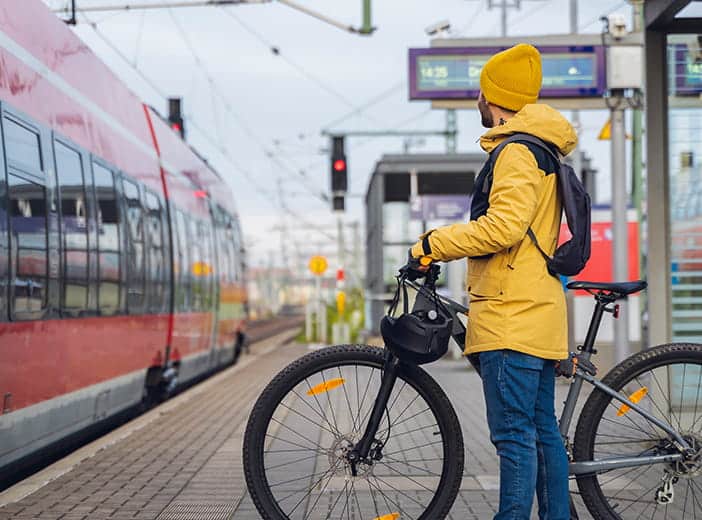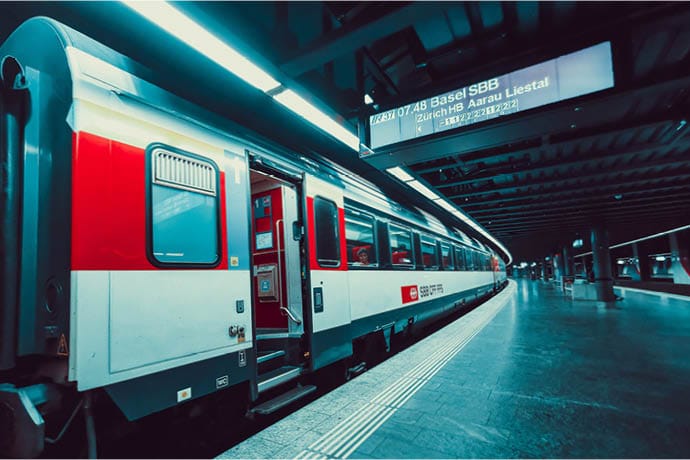Driving change with smart city mobility data sharing

Seamless mobility is at the heart of effective and popular cities. Sharing data across the mobility ecosystem increases transparency, collaboration and efficiency, enabling smart city mobility that benefits businesses, citizens, transport operators and city government.
Successful cities rely on people being able to move around freely, whether by car, public transport, bike or on foot. Good urban mobility is a key factor in attracting businesses, residents and visitors and building a vibrant, efficient, sustainable city. After all, no-one wants to be stuck in traffic congestion, waste their time waiting for a bus that never arrives, feel unsafe as a pedestrian, or spend hours searching for a parking space.
Data is the essential fuel for mobility, keeping the entire ecosystem informed and allowing it to react in real-time to changing conditions. This blog explains how cities can harness data to drive smart city mobility.
The importance of mobility to smart cities
Despite its importance, mobility is an issue in cities across North America. The average US driver spent 51 hours in traffic jams in 2022, according to data from Inrix, costing them $869 in lost time alone. This adds up to a total cost to the US economy of $81 billion, with major cities particularly hard hit. Congestion costs New York $10.2 billion and Chicago $9.5 billion for example. And this doesn’t include the lost revenues or tax dollars when people or organizations decide to relocate elsewhere, due to mobility issues.
No wonder that mobility is one of the key pillars of successful smart cities, helping improve travel, save time, cut emissions, and make cities more liveable. However, creating efficient mobility within cities is not easy – it involves:
- multiple players (including city government, transport operators, drivers, passengers, pedestrians and businesses),
- huge numbers of interconnecting variables (cars, buses, bikes),
- rapid changes due to both human behavior and new events (such as weather conditions, accidents or breakdowns in infrastructure).
Building a successful mobility ecosystem is all about cooperation and collaboration, and this can only be underpinned through real-time data, shared amongst participants. Smart city infrastructure such as cameras and Internet of Things (IoT) sensors that measure traffic, footfall and pollution, all linked by robust networks, needs to collect this data, integrate different systems and then share it with the entire ecosystem in ways that it can be used easily. Data must be collected ethically and transparently, protecting privacy and security to ensure citizens understand and buy into smart mobility programs.
The benefits of smart city mobility
Implementing a smart city data sharing platform that centralizes and shares information benefits everyone involved in mobility within the city.
Providing a seamless experience to drivers
Cities can automatically share real-time traffic data with drivers through apps and integration with sat-nav systems. This enables them to re-route to avoid congestion or incidents such as roadwork, keeping the city running smoothly. Sharing data from parking sensors can flag the nearest free parking space, avoiding the need to spend time (and fuel) driving around searching for one. Overall, this provides a more seamless, pleasant driving experience, encouraging people to drive into the city for work or leisure.
Optimizing journeys for transport passengers
Many people would rather take public transport instead of driving, but are put off by their lack of control. They are unsure whether buses will arrive on time, whether they will integrate with other stages of their journey (such as trains) or if they will become stuck in traffic. Joining up mobility data from multiple providers and city authorities and sharing it through apps, dashboards and signage overcomes these reservations. Passengers should be able to book their end-to-end journey in one place, covering everything from trains and buses to bike and e-scooter hire. Being able to see the progress of their journey in real-time delivers reassurance and increases usage. Smart cities therefore require collaboration between all providers to share data in the right formats, whether from sensors, vehicles, cameras or back end billing systems.
Increasing opportunities for transport operators
Many public transport operators such as subways, transit systems or bus networks have struggled financially post-pandemic as more people work from home and limit their journeys into the city. Sharing data across the mobility ecosystem encourages passengers to return by making their journeys seamless, but also opens up new revenue opportunities, such as by selling end-to-end tickets across multi-modal transport. Analyzing data helps pinpoint where networks can be optimized, such as by rerouting or re-timing buses or trains, or launching new routes in response to passenger demand.
Supporting liveable, sustainable cities and municipalities
Attracting and retaining businesses, residents and visitors is crucial to creating living, vibrant communities. In an era of increasing competition, cities of all sizes need to provide the right experience to thrive. Mobility is central to this, with people demanding choice over how they get around and desiring control over their journeys. Smart mobility solutions meet this need, increasing investment in cities and growing tax revenues. Optimizing mobility, such as by reducing traffic congestion and encouraging public transport usage also feeds into environmental goals. It lowers emissions, improves air quality and creates more liveable cities for all.
Creating a safe environment for pedestrians and cyclists
Many people are put off from walking or cycling around cities because of a lack of supporting infrastructure and fears around safety. Putting in place the right smart city sensors and sharing data overcomes these challenges and helps make cities more people-centric and inviting. For example, pedestrian sensors can be used to monitor areas for congestion and their anonymized data then used to optimize flows across the city. Analysis shows popular routes and where infrastructure (such as crossings and sidewalks) need to be upgraded to maximize safety, reduce congestion, and improve journeys. Intelligent cycling infrastructure, such as e-bike hire schemes, can be integrated with other transport options and new, car-free routes created and shared via mobility apps to encourage greater usage.
The future of smart city mobility
Data sharing between mobility players is already enabling smarter, more efficient urban transport that benefits everyone involved. However, the roll-out of new technologies, from 5G networks and artificial intelligence to autonomous vehicles promise to transform smart mobility and make it even simpler to get from A to B.
5G networks
5G networks enable the faster transmission of larger volumes of data in real-time. This gives city authorities even greater control over the changing mobility landscape and enables them to react more quickly to events. By collecting more detailed data they can keep drivers and pedestrians better informed and take faster action, such as to close a road in case of an accident.
IoT sensors
While sensors are not new, their use is spreading exponentially as prices drop and use cases increase. Sensors can now be easily added to all types of existing equipment, such as traffic lights and vehicles, as well as being embedded within the fabric of the urban environment to monitor all aspects of mobility.
Artificial intelligence
AI relies on data. Greater access to data enables AI to make more informed decisions and more accurate predictions. For example, it can be used to model the impact on journey times, traffic congestion, and emissions of closing roads or adding a bus lane within digital twins. Alternatively, it can predict how traffic flows will change depending on outside conditions such as the weather or planned sporting events.
Autonomous vehicles
Cities around the world are already testing autonomous vehicles, both to transport passengers and goods. These have the potential to transform urban mobility and reduce congestion, yet require careful monitoring and complete transparency to convince communities that they are safe and meet their needs.
The CASSI shuttle trial is the perfect example of the importance of data sharing to autonomous transport. A partnership between the North Carolina Department of Transportation and the Town of Cary, the trial saw the introduction of an all-electric self-driving shuttle to the town’s Bond Park. All of the data around the project is available on Cary’s open data portal, through dashboards and data stories, providing a completely transparent view of performance, including number of riders, reasons for service disruption and most popular times and days of week for usage. All of this helps build confidence and drive improvements in the technology in a real-world setting.
Mobility is vital to keeping cities flowing, attracting businesses, residents and visitors and improving efficiency. None of this can happen without data sharing, making smart city mobility central to urban success, whatever the size of your city.

Driven by the need to decarbonize, increase efficiency and meet changing customer needs, the transport and mobility sector is undergoing a rapid transformation. Data is at the heart of this, with data portals critical to building an effective, sustainable and customer-centric transport ecosystem.

More and more public sector organizations are committing to taking an open data approach. They can see how open data helps to connect directly with citizens and builds a stronger, trusted relationship between citizens and public sector bodies.

In the relaxing seaside town of Pesaro, central Italy, moving around has never been more convenient – nor more sustainable. Imagine looking for a parking spot, paying for the actual time you occupied it, renting a bike, finding your way through the Bicipolitana – through just one app.

